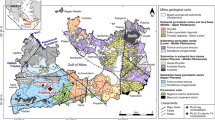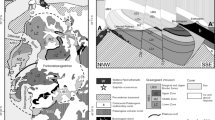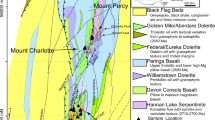Abstract
Stratigraphic offsets in the peak concentrations of platinum-group elements (PGE) and base-metal sulfides in the main sulfide zone of the Great Dyke and the precious metals zone of the Sonju Lake Intrusion have, in part, been attributed to the interaction between magmatic PGE-bearing base-metal sulfide assemblages and hydrothermal fluids. In this paper, we provide mineralogical and textural evidence that indicates alteration of base-metal sulfides and mobilization of metals and S during hydrothermal alteration in both mineralized intrusions. Stable isotopic data suggest that the fluids involved in the alteration were of magmatic origin in the Great Dyke but that a meteoric water component was involved in the alteration of the Sonju Lake Intrusion. The strong spatial association of platinum-group minerals, principally Pt and Pd sulfides, arsenides, and tellurides, with base-metal sulfide assemblages in the main sulfide zone of the Great Dyke is consistent with residual enrichment of Pt and Pd during hydrothermal alteration. However, such an interpretation is more tenuous for the precious metals zone of the Sonju Lake Intrusion where important Pt and Pd arsenides and antimonides occur as inclusions within individual plagioclase crystals and within alteration assemblages that are free of base-metal sulfides. Our observations suggest that Pt and Pd tellurides, antimonides, and arsenides may form during both magmatic crystallization and subsolidus hydrothermal alteration. Experimental studies of magmatic crystallization and hydrothermal transport/deposition in systems involving arsenides, tellurides, antimonides, and base metal sulfides are needed to better understand the relative importance of magmatic and hydrothermal processes in controlling the distribution of PGE in mineralized layered intrusions of this type.









Similar content being viewed by others
References
Armstrong R, Wilson AH (2000) A SHRIMP U–Pb study of zircons from the layered sequence of the Great Dyke, Zimbabwe, and a granitoid dyke. Earth Planet Sci Lett 180:1–12
Boudreau AE, McCallum IS (1992) Concentration of platinum-group elements by fluids in layered intrusion. Econ Geol 87:1830–1848
Boudreau AE, Meurer WP (1999) Chromatographic separation of the platinum-group elements, gold, base-metals and sulfur during degassing of a compacting and solidifying igneous crystal pile. Contrib Mineral Petrol 134:74–185
Campbell IH, Barnes SJ (1984) A model for the geochemistry of the platinum group elements in magmatic sulfide deposits. Can Miner 22:151–160
Campbell IH, Naldrett AJ, Barnes SJ (1983) A model for the origin of the platinum rich sulfide horizons in the Bushveld and Stillwater Complexes. J Petrol 24:133–165
Clayton RN, Mayeda TK (1963) The use of bromine pentafluride in the extraction of oxygen from oxides and silicates for isotopic analysis. Geochim Cosmochim Acta 27:43–52
Helmy HM, Ballhaus C, Berndt J, Bockrath C, Wohlgemuth-Ueberwasser C (2006) Formation of Pt, Pd and Ni tellurides: experiments in sulfide-telluride systems. Contrib Mineral Petrol 153(5):577–591
Joslin GD (2004) Stratiform palladium–platinum–gold mineralization in the Sonju Lake Intrusion, Lake County, Minnesota. MS thesis, University of Minnesota–Duluth, p 185
Li C, Ripley EM, Merino M, Maier WD (2004) Replacement of base metal sulfides by actinolite, epidote, calcite and magnetite in the UG2 and Merensky Reef of the Bushveld Complex, South Africa. Econ Geol 99:173–184
Miller JD Jr (1999) Geochemical evaluation of platinum group element (PGE) mineralization in the Sonju Lake Intrusion, Finland, Minnesota. Minnesota Geological Survey Information Circular 44, p 32
Miller JD Jr, Chandler VW (1997) Geology, petrology, and tectonic significance of the Beaver Bay Complex, northeastern Minnesota. In: Ojakanga RJ, Dickas AB, Green JC (eds) Middle Proterozoic and Cambrian rifting, Central North America. Geological Society of America Special Paper 312, pp 73–96
Miller JD Jr, Ripley EM (1996) Layered intrusions of the Duluth Complex, Minnesota, USA. In: Cawthorn RG (ed), Layered mafic igneous complexes. Elsevier, Amsterdam, pp 257–302
Miller JD Jr, Green JC, Severson MJ, Chandler VW, Hauck SA, Peterson DM, Wahl TE (2002) Geology and mineral potential of the Duluth Complex and related rocks of Northeastern Minnesota. Minnesota Geological Survey Report of Investigations 58, p 207
Naldrett AJ, Wilson AH (1990) Horizontal and vertical variations in noble metals in the Great Dyke of Zimbabwe: a model for the origin of PGE mineralization by fractional segregation. Chem Geol 88:279–300
Oberthür T, Cabri LJ, Weiser TW, McMahon G, Müller P (1997) Pt, Pd and other trace elements in sulfides of the Main Sulfide Zone, Great Dyke, Zimbabwe-a reconnaissance study. Can Miner 35:597–609
Oberthür T, Davis DW, Blenkinsop TG, Höhndorf A (2002) Precise U–Pb mineral ages, Rb–Sr and Sm–Nd systematics for the Great Dyke, Zimbabwe—constraints on late Archean events in the Zimbabwe Craton and Limpopo Belt. Precambrian Res 113:293–305
Oberthür T, Weiser TW, Gast L, Kojonen K (2003) Geochemistry and mineralogy of platinum-group elements at Hartley Platinum Mine, Zimbabwe. Miner Depos 38:327–343
Paces JB, Miller JD Jr (1993) Precise U–Pb ages of Duluth Complex and related mafic intrusion, northeastern Minnesota—new insights from physical, petrologic, paleomagnetic and tectono-magmatic processes associated with 1.2 Ga Midcontient rifting. J Geophys Res 98:13997–14012
Park Y-R, Ripley EM, Miller JD Jr, Li C, Mariga J, Shafer P (2004) Stable isotopic constraints on fluid–rock interaction and Cu–PGE–S redistribution in the Sonju Lake Intrusion, Minnesota. Econ Geol 99:325–338
Podmore F, Wilson AH (1987) A reappraisal of the structure, geology and emplacement of the Great Dyke, Zimbabwe. In: Halls HC, Fahrig WF (eds) Mafic dyke swarms. Geological Association of Canada, Special Paper 34, pp 433–444
Prendergast MD, Keays RR (1989) Controls of platinum group element mineralization and the origin of the PGE-rich main sulphide zone of the Great Dyke, Zimbabwe: implications for the genesis of, and the exploration for stratiform PGE mineralization in layered intrusions. In: Prendergast MD, Jones MJ (eds) Magmatic Sulphides—the Zimbabwe volume. Institute of Mining and Metallurgy, London, pp 43–69
Ripley EM (1999) Systematics of sulfur and oxygen isotopes in mafic igneous rocks and related Cu–Ni–PGE mineralization. In: Keays RR, Lesher CM, Lightfoot PC, Farrow CEG (eds) Dynamic processes in magmatic ore deposits and their application in mineral exploration. Geological Association of Canada Short Course Notes 13, pp 133–158
Sharp ZD, Atudorei V, Durakiewiez T (2001) A rapid method for determination of hydrogen and oxygen isotope ratios from water and hydrous minerals. Chem Geol 173:197–201
Studley SA, Ripley EM, Elswick ER, Dorais MJ, Fong J, Finkelstein D, Pratt LM (2002) Analysis of sulfides in whole rock matrices by elemental analyzer-continuous flow isotope ratio mass spectrometry. Chem Geol 192:141–148
Suzuoki T, Epstein S (1976) Hydrogen isotopic fractionation between OH-bearing minerals and water. Geochim Cosmochim Acta 40:1229–1240
Tredoux M, Lindsay NM, Davies G, McDonald I (1995) The fractionation of platinum-group elements in magmatic systems, with the suggestion of a novel causal mechanism. South Africa Journal of Geology 98:157–167
Wilson AH (1982) The geology of the Great Dyke, Zimbabwe: the ultramafic rocks. J Petrol 23:240–292
Wilson AH (1996) The Great Dyke of Zimbabwe. In: Cawthorn RG (ed) Layered Intrusions. Elsevier, Amsterdam, pp 365–402
Wilson AH (2001) Compositional and lithological controls on the PGE-bearing sulphide zones in the Selukwe subchamber, Great Dyke: a combined equilibrium-Rayleigh fractionation model. J Petrol 42:1845–1867
Wilson AH, Prendergast MD (1989) The Great Dyke of Zimbabwe-I: tectonic setting, stratigraphy, petrology, structure, emplacement and crystallisation. In: Prendergast MD, Jones MJ (eds) Magmatic sulphides—the Zimbabwe volume. Institute of Mining and Metallurgy, London, pp 1–20
Wilson AH, Naldrett AJ, Tredoux M (1989) Distribution and controls of platinum-group element and base-metal mineralization in the Darwendale subchamber of the Great Dyke, Zimbabwe. Geology 17:649–652
Wilson AH, Murahwi CZ, Coghill B (2000) Stratigraphy, geochemistry and platinum group element mineralisation of the central zone of the Selukwe Subchamber, Great Dyke, Zimbabwe. J Afr Earth Sci 30:833–853
Worst BG (1960) The Great Dyke of Southern Rhodesia. Southern Rhodesia Geological Survey Bulletin 47, p 234
Zheng YF (1993) Calculation of oxygen isotope fractionation in hydroxyle-bearing silicates. Earth Planet Sci Lett 120:247–263
Acknowledgments
We are indebted to G.L. Holland and R. Brown of BHP-Hartley Platinum Mine and P. Vanderspuy, H. Wilhelmij and H. O’Keeffe of Zimplats for their continuous support of our field work in Zimbabwe. Paula Shafer and Joyashish Thakurta are thanked for their assistance in isotope analysis. Careful reviews by Andy Kerr and Edward Pattison are appreciated. Partial financial support for this work was provided through grants from the NSF of China (40534020), the Ministry of Education of China (Project 111-B07011) and the NSF of the United States (EAR-0335131).
Author information
Authors and Affiliations
Corresponding author
Additional information
Editorial handling: P. Lightfoot
Rights and permissions
About this article
Cite this article
Li, C., Ripley, E.M., Oberthür, T. et al. Textural, mineralogical and stable isotope studies of hydrothermal alteration in the main sulfide zone of the Great Dyke, Zimbabwe and the precious metals zone of the Sonju Lake Intrusion, Minnesota, USA. Miner Deposita 43, 97–110 (2008). https://doi.org/10.1007/s00126-007-0159-x
Received:
Accepted:
Published:
Issue Date:
DOI: https://doi.org/10.1007/s00126-007-0159-x




